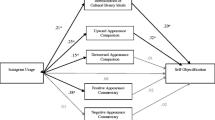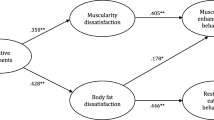Abstract
The present research had two goals: (1) to document how health advice is framed on the covers of women’s health magazines, and (2) to investigate whether exposure to appearance frames (i.e., do something in order to look better) affected women’s body-related self-perceptions compared to health frames (i.e., to do something in order to feel better). Study 1, a content analysis of 426 cover headlines on the five highest-circulating women’s health magazines in the United States, revealed that appearance frames were just as prevalent as health frames. Study 2, an experiment conducted on 103 U.S. undergraduate women, showed that those assigned to appearance frames reported more body shame and appearance-related motivation to exercise than women assigned to health frames.
Similar content being viewed by others
References
Archer, D., Iritani, B., Kimes, D. D., & Barrios, M. (1983). Face-ism: Five studies of sex differences in facial prominence. Journal of Personality and Social Psychology, 45, 725–735.
Aubrey, J. S. (2006a). Effects of sexually objectifying media on self-objectification and body surveillance in undergraduates: Results of a 2-year panel study. Journal of Communication, 56, 366–386. doi:10.1111/j.1460-2466.2006.00024.x.
Aubrey, J. S. (2006b). Exposure to sexually objectifying media and body self-perceptions among college women: An examination of the selective exposure hypothesis and the role of moderating variables. Sex Roles, 55, 159–172. doi:10.1007/s11199-006-9070-7.
Aubrey, J. S., Henson, J., Hopper, K. M., & Smith, S. E. (2009). A picture is worth twenty words (about the self): Testing the priming influence of visual sexual objectification on women’s self-objectification. Communication Research Reports, 26, 271–284. doi:10.1080/08824090903293551.
Audit Bureau of Circulations (2010). Retrieved from http://www.accessabc.com/services/circulation.htm.
Barker, E. T., & Galambos, N. L. (2003). Body dissatisfaction of adolescent girls and boys: Risk and resource factors. Journal of Early Adolescence, 23, 141–165. doi:10.1177/0272431603023002002.
Bartky, S. L. (1990). Femininity and domination: Studies in the phenomenology of oppression. New York: Routledge.
Berkowitz, L. (1986). Situational influences on reactions to observed violence. Journal of Social Issues, 42, 93–106.
Bordo, S. (1993). Unbearable weight: Feminism, western culture, and the body. Berkeley: University of California Press.
Cappella, J. N., & Jamieson, K. H. (1996). News frames, political cynicism, and media cynicism. Annals of the American Academy of Political and Social Science, 546, 71–84. Retrieved from http://www.jstor.org/stable/1048171.
Centers for Disease Control and Prevention (2007, November 28). New CDC study finds no increase in obesity among adults: But levels still high. Retrieved from http://www.cdc.gov/nchs/pressroom/07newsreleases/obesity.htm.
Centers for Disease Control and Prevention (2010). Healthy weight—it’s not a diet, it’s a lifestyle. Retrieved from: http://www.cdc.gov/nchs/pressroom/07newsreleases/obesity.htm.
Davalos, D. B., Davalos, R. A., & Layton, H. S. (2007). Content analysis of magazine headlines: Changes over three decades? Feminism & Psychology, 17, 250–258. doi:10.1177/0959353507076559.
de Beauvoir, S. (1952). The second sex (H. M. Parshley, Trans.). New York: Knopf.
Fitness (2010). Editorial. Retrieved from http://www.meredith.com/mediakit/fitness/index.html.
Fouts, G., & Burggraf, K. (1999). Television situation comedies: Female body images and verbal reinforcements. Sex Roles, 40, 473–481.
Fredrickson, B. L., & Roberts, T.-A. (1997). Objectification theory: Toward an understanding women’s lived experiences and mental health risks. Psychology of Women Quarterly, 21, 173–206.
Fredrickson, B. L., Roberts, T.-A., Noll, S. M., Quinn, D. M., & Twenge, J. M. (1998). That swimsuit becomes you: Sex differences in self-objectification, restrained eating, and math performance. Journal of Personality and Social Psychology, 75, 269–284.
Furnham, A., Badmin, N., & Sneade, I. (2002). Body image dissatisfaction: Gender differences in eating attitudes, self-esteem, and reasons for exercise. Journal of Psychology, 136, 581–596.
Glass, G. V., & Hopkins, K. D. (1996). Statistical methods in education and psychology (3rd ed.). Englewood Cliffs: Prentice-Hall.
Goffman, E. (1979). Gender advertisements. Cambridge: Harvard University Press.
Groesz, L. M., Levine, M. P., & Murnen, S. K. (2002). The effect of experimental presentation of thin media images on body satisfaction: A meta-analytic review. International Journal of Eating Disorders, 31, 1–16. doi:10.1002/eat.10005.
Hardin, M., Lynn, S., & Walsfor, K. (2005). Challenge and conformity on “contested terrain:” Images of women in four women’s sports/fitness magazines. Sex Roles, 53, 105–117. doi:10.1007/s11199-005-4285-6.
Hargreaves, J. (1994). Sporting women. London: Routledge.
Harper, B., & Tiggemann, M. (2008). The effect of thin ideal media images on women’s self-objectification, mood, and body image. Sex Roles, 58, 649–657. doi:10.1007/s11199-007-9379-x.
Harrison, K., & Fredrickson, B. (2003). Women’s sports media, self-objectification, and mental health in Black and White adolescent females. Journal of Communication, 53, 216–232.
Jennings, J., Geis, F. L., & Brown, V. (1980). Influence of television commercials on women’s self-confidence and independent judgment. Journal of Personality and Social Psychology, 38, 203–210.
Kilbourne, J. (1999). Can’t buy my love: How advertising changes the way we think and feel. New York: Simon & Schuster.
Malkin, A. R., Wornian, K., & Chrisler, J. C. (1999). Women and weight: Gendered messages on magazines covers. Sex Roles, 40, 647–655. doi:10.1023/A:1018848332464.
McKenzie-Mohr, D., & Zanna, M. P. (1990). Treating women as sexual objects: Look to the (gender schematic) man who has viewed pornography. Personality and Social Psychology Bulletin, 16, 296–308.
Noll, S. M. (1996). The relationship between sexual objectification and disordered eating: Correlational and experimental tests of body shame as a mediator. Unpublished doctoral dissertation, Duke University, Durham, NC.
Noll, S. M., & Fredrickson, B. L. (1998). A mediational model linking self-objectification, body shame, and disordered eating. Psychology of Women Quarterly, 22, 623–636.
O’Dea, J. A., & Abraham, S. (1999). Association between self-concept and body weight, gender, and pubertal development among male and female adolescents. Adolescence, 34, 69–79.
Oliver, M. B. (2002). Individual differences in media effects. In J. Bryant & D. Zillman (Eds.), Media effects: Advances in theories and research (2nd ed., pp. 507–524). Mahwah: Erlbaum.
Price, V., & Tewksbury, D. (1997). News values and public opinion: A theoretical account of media priming and framing. In G. Barnett & F. J. Boster (Eds.), Progress in the communication sciences (pp. 173–212). Norwood: Ablex Pub. Corp.
Prichard, I., & Tiggemann, M. (2005). Objectification in fitness centers: Self-objectification, body dissatisfaction, and disordered eating in aerobic instructors and aerobic participants. Sex Roles, 52, 19–28. doi:10.1007/s11199-005-4270-0.
Prichard, I., & Tiggemann, M. (2007). Relations among exercise type, self-objectification, and body image in the fitness centre environment: The role of reasons for exercise. Psychology of Sport and Exercise, 9, 855–866. doi:10.1016/j.psychsport.2007.10.005.
Putterman, E., & Linden, W. (2004). Appearance versus health: Does the reason for dieting affect dieting behavior? Journal of Behavioral Medicine, 27, 185–204. doi:0160-7715/04/0400-0185/0.
Rudman, L. A., & Borgida, E. (1995). The afterglow of construct accessibility: The behavioral consequences of priming men to view women as sexual objects. Journal of Experimental Social Psychology, 31, 493–517.
Rudman, W. J., & Hagiwara, A. F. (1992). Sexual exploitation in advertising health and wellness products. Women & Health, 18, 77–89. Retrieved from www.cinahl.com/cgi-bin/refsvc?jid=353&accno=1994184110.
Ryan, R. M., & Deci, E. L. (2000). Self-determination theory and the facilitation of intrinsic motivation, social development, and well-being. American Psychologist, 55(1), 68–78.
Scheufele, D. A. (1999). Framing as a theory of media effects. Journal of Communication, 49, 103–122.
Shape Magazine Online (2010). 10 reasons to get in shape. Retrieved from http://www.americanmediainc.com/mediakits/shape/pdf/shape_editorial.pdf.
Shape Magazine Online (2010) Shape magazine online. Retrieved from http://www.americanmediainc.com/mediakits/shape/kit_online.htm.
Silberstein, L. R., Striegel-Moore, R. H., Timko, C., & Rodin, J. (1988). Behavioral and psychological implications of body dissatisfaction: Do men and women differ? Sex Roles, 19, 219–232.
Sommers-Flanagan, R., Sommers-Flanagan, J., & Davis, B. (1993). What’s happening on music television? A gender role content analysis. Sex Roles, 28, 745–753.
Steinem, G. (2003). Sex, lies, and advertising. In G. Dines & J. M. Humez (Eds.), Gender, race, and class in media: A text-reader (2nd ed., pp. 223–229). Thousand Oaks: Sage (Reprinted from Sex, lies, and advertising. Ms. Magazine, 1990, July/August).
Strelan, P., Mehaffey, S. J., & Tiggemann, M. (2003). Self-objectification and esteem in young women: The mediating role of reasons for exercise. Sex Roles, 48, 89–95. doi:10.1023/A:1022300930307.
Thomsen, S. R. (2002). Health and beauty magazine reading and body shape concerns among a group of college women. Journalism and Mass Communication Quarterly, 79, 988–1007.
Thomsen, S. R., Bower, D. W., & Barnes, M. D. (2004). Photographic images in women’s health, fitness, and sports magazines, and the physical self-concept of a group of adolescent female volleyball players. Journal of Sport & Social Issues, 28, 266–283. doi:10.1177/0193723504266991.
Tiggemann, M., & Williamson, S. (2000). The effect of exercise on body satisfaction and self-esteem as a function of gender and age. Sex Roles, 43, 119–127. doi:10.1023/A:1007095830095.
Author information
Authors and Affiliations
Corresponding author
Rights and permissions
About this article
Cite this article
Aubrey, J.S. Looking Good Versus Feeling Good: An Investigation of Media Frames of Health Advice and Their Effects on Women’s Body-related Self-perceptions. Sex Roles 63, 50–63 (2010). https://doi.org/10.1007/s11199-010-9768-4
Published:
Issue Date:
DOI: https://doi.org/10.1007/s11199-010-9768-4




